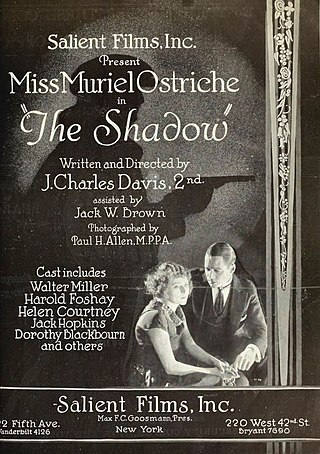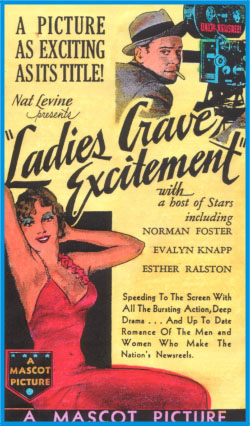Republic Pictures
Mascot's film laboratory was Consolidated Film Industries. In 1935, under pressure from that company's owner, Herbert Yates, Mascot was merged by CFI with Monogram Pictures, Liberty Pictures, Chesterfield Pictures and Invincible Pictures to form Republic Pictures, a production-distribution company designed by Yates. Levine was designated head of the serial and B-Western arm of the company, and the Mascot studio facilities and contract personnel became Republic assets as part of the merger. Within two years, however, along with most of his colleagues at Republic who had owned other companies, Levine found himself in a disagreeable situation and left Republic. With only the Mascot name and film library remaining in his possession, Levine found employment elsewhere in the motion picture industry and Mascot Pictures survived only through reissues of its sound serials and a single, new feature film edited from the "Phantom Empire" serial, released in 1940.

Republic Pictures is currently an acquisition-only label owned by Paramount Pictures. Its history dates back to Republic Pictures Corporation, an American film studio that originally operated from 1935 to 1967, based in Los Angeles, California. It had production and distribution facilities in Studio City, as well as a movie ranch in Encino.

Herbert John Yates, a Hollywood mini-mogul, was the founder and President of Republic Pictures. With his contract, he had launched the film careers of such Western stars as Roy Rogers, Gene Autry, and John Wayne. Between 1935 and 1959, under the supervising leadership of Yates, Republic has produced 956 feature films and 66 multi-chapter cliffhanger serials, some of which are today considered classics, later broadcast on television and then released on home video.

Kenneth Olin Maynard was an American actor and producer. He was mostly active from the 1920s to the 1940s and considered one of the biggest Western stars in Hollywood.

Frankie Darro was an American actor and later in his career a stuntman. He began his career as a child actor in silent films, progressed to lead roles and co-starring roles in adventure, western, dramatic, and comedy films, and later became a character actor and voice-over artist. He is perhaps best known for his role as Lampwick, the unlucky boy who turns into a donkey in Walt Disney's second animated feature, Pinocchio (1940). In early credits, his last name was spelled Darrow.

Tom Tyler was an American actor known for his leading roles in low-budget Western films in the silent and sound eras, and for his portrayal of superhero Captain Marvel in the 1941 serial film The Adventures of Captain Marvel. Tyler also played Kharis in 1940's The Mummy's Hand, a popular Universal Studios monster film.

John Paterson McGowan was a pioneering Hollywood actor and director and occasionally a screenwriter and producer. McGowan remains the only Australian to have been made a life member of the Screen Directors Guild.
Poverty Row is a slang term for small Hollywood studios that produced B movies from the 1920s to the 1950s, typically with much smaller budgets and lower production values than those of the major studios. Although many of these studios were based in the vicinity of Gower Street in Hollywood, the term does not necessarily relate to any specific physical location.
John Wilkinson English was a British film editor and film director. He is most famous for the film serials he co-directed with William Witney for Republic Pictures such as Zorro's Fighting Legion and Drums of Fu Manchu.

Jasper Joseph Inman Kane was an American film director, film producer, film editor and screenwriter. He is best known for his extensive directorship and focus on Western films.
David Ross Lederman was an American film director noted for his Western, action, and adventure films of the 1930s and 1940s.

Walter Miller was an American actor of the silent era and the early sound era. He appeared in nearly 250 films between 1911 and 1940.
Nat Levine, was an American film producer. He produced 105 films between 1921 and 1946. Born in New York City, he entered the film industry as an accountant for Metro Pictures and became personal secretary to Metro head Marcus Loew.

Elizabeth Burbridge was an American screenwriter and actress, best known for her Western screenplays.
Lee Zahler was an American composer and musical director of films, starting in the 1920s and well into the 1940s.
Lawrence J. Darmour (1895–1942) was an American film producer, operator of Larry Darmour Productions from 1927, and a significant figure in Hollywood's low-budget production community.

William Nobles was an American cinematographer.
Tremlet C. Carr was an American film producer, closely associated with the low-budget filmmaking of Poverty Row. In 1931 he co-founded Monogram Pictures, which developed into one of the leading specialist producers of B pictures in Hollywood.
Edward Llewellyn Totman, known professionally as Wellyn Totman was a film and television screenwriter in Hollywood. His work includes original stories and adaptations, such as the Mascot Pictures movie serial The Miracle Rider starring Tom Mix. He also wrote several Republic Pictures films. He was born and raised in Duluth, Minnesota.

A serial film,film serial, movie serial, or chapter play, is a motion picture form popular during the first half of the 20th century, consisting of a series of short subjects exhibited in consecutive order at one theater, generally advancing weekly, until the series is completed. Usually, each serial involves a single set of characters, protagonistic and antagonistic, involved in a single story, which has been edited into chapters after the fashion of serial fiction and the episodes cannot be shown out of order or as a single or a random collection of short subjects.












